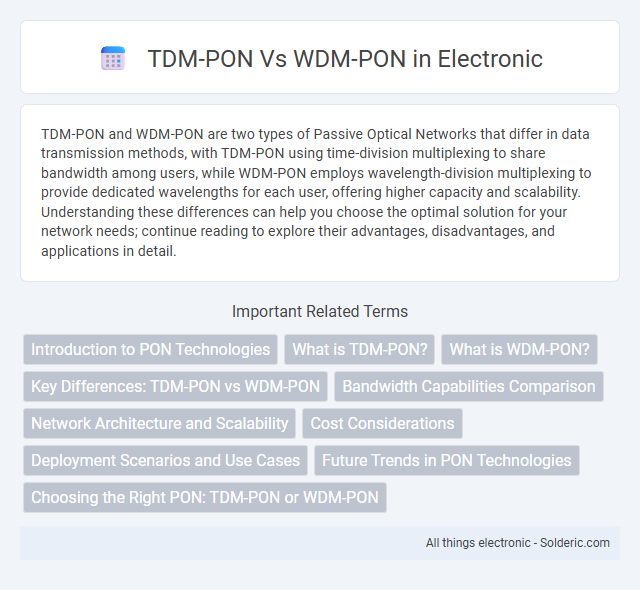TDM-PON and WDM-PON are two types of Passive Optical Networks that differ in data transmission methods, with TDM-PON using time-division multiplexing to share bandwidth among users, while WDM-PON employs wavelength-division multiplexing to provide dedicated wavelengths for each user, offering higher capacity and scalability. Understanding these differences can help you choose the optimal solution for your network needs; continue reading to explore their advantages, disadvantages, and applications in detail.
Comparison Table
| Feature | TDM-PON (Time Division Multiplexing PON) | WDM-PON (Wavelength Division Multiplexing PON) |
|---|---|---|
| Technology | Shares a single wavelength using time slots | Assigns unique wavelength per user |
| Bandwidth | Limited by total shared bandwidth | High; dedicated bandwidth per user |
| Scalability | Moderate; limited by number of time slots | High; scalable by adding wavelengths |
| Security | Lower; users share same wavelength and time | High; dedicated wavelengths improve privacy |
| Cost | Lower; mature technology and simpler hardware | Higher; requires wavelength-specific components |
| Complexity | Lower; simpler OLT and ONU design | Higher; needs wavelength management and tuning |
| Deployment | Widespread; used in many current PON networks | Emerging; suitable for high bandwidth demands |
| Latency | Higher due to time slot scheduling | Lower; dedicated channels reduce delay |
Introduction to PON Technologies
Passive Optical Networks (PON) utilize fiber optic technology to deliver high-speed internet by sharing a single optical fiber among multiple users. TDM-PON (Time Division Multiplexing PON) divides bandwidth by time slots to serve multiple users sequentially, making it cost-effective and suitable for residential deployments. WDM-PON (Wavelength Division Multiplexing PON) assigns unique wavelengths to users, offering higher bandwidth and dedicated connections ideal for business or high-demand applications, enabling Your network to achieve greater scalability and performance.
What is TDM-PON?
TDM-PON (Time Division Multiplexing Passive Optical Network) is a fiber-optic communication technology that shares a single optical fiber among multiple users by allocating specific time slots for data transmission, ensuring efficient bandwidth utilization. It uses passive splitting to distribute signals without requiring active electronic devices between the central office and end users, reducing operational costs and complexity. Your network can benefit from TDM-PON's cost-effectiveness and scalability for delivering high-speed internet services in residential and business environments.
What is WDM-PON?
WDM-PON (Wavelength Division Multiplexing Passive Optical Network) is an advanced fiber-optic access technology that uses multiple wavelengths or colors of light to transmit data simultaneously over a single optical fiber. This method significantly increases bandwidth capacity and enables dedicated, high-speed connections for individual users or devices, providing enhanced security and reducing network congestion. Compared to TDM-PON (Time Division Multiplexing PON), WDM-PON offers superior scalability and performance, making it ideal for future-proofing your network infrastructure.
Key Differences: TDM-PON vs WDM-PON
TDM-PON (Time Division Multiplexing Passive Optical Network) and WDM-PON (Wavelength Division Multiplexing Passive Optical Network) differ primarily in their multiplexing techniques; TDM-PON uses time slots to share bandwidth among users, while WDM-PON assigns distinct wavelengths to each user, enabling higher data capacity and dedicated channels. WDM-PON offers better scalability, greater bandwidth efficiency, and reduced signal interference compared to TDM-PON, making it ideal for future-proof, high-demand networks. Your choice between these technologies depends on network complexity, cost considerations, and the need for bandwidth per user.
Bandwidth Capabilities Comparison
TDM-PON offers shared bandwidth by dividing time slots among users, which can limit the total available bandwidth per user during peak times. WDM-PON provides dedicated wavelengths to each user, enabling significantly higher bandwidth capacity and minimizing signal interference. Your network's scalability and future-proofing benefit more from WDM-PON's superior bandwidth capabilities compared to TDM-PON.
Network Architecture and Scalability
TDM-PON employs time-division multiplexing to share a single wavelength among multiple users, leading to a simpler and cost-effective network architecture with limited scalability due to bandwidth splitting. WDM-PON utilizes wavelength-division multiplexing, assigning dedicated wavelengths to each user, enabling higher bandwidth per subscriber and enhanced scalability by supporting more users without performance degradation. The WDM-PON architecture is more complex and costly but offers future-proof scalability, making it preferable for high-demand, large-scale deployments.
Cost Considerations
TDM-PON systems generally offer lower initial deployment costs due to shared infrastructure and simpler optical components, making them suitable for cost-sensitive access networks. WDM-PON incurs higher expenses stemming from individual wavelength allocation per user, which requires advanced lasers and precise wavelength management, increasing both capital and operational expenditures. Long-term scalability and bandwidth demands may justify the higher investment in WDM-PON for networks requiring dedicated high-capacity channels.
Deployment Scenarios and Use Cases
TDM-PON is ideal for cost-effective, high-density residential broadband deployments where bandwidth demands are moderate and shared among multiple users. WDM-PON suits enterprise environments and data centers requiring dedicated, high-capacity, point-to-point connections with enhanced security and minimal latency. Deployment of WDM-PON is favored in scenarios demanding scalable, future-proof infrastructure supporting diverse services such as 5G fronthaul and business VLANs.
Future Trends in PON Technologies
TDM-PON remains a cost-effective solution for high-density residential deployments but faces scalability challenges as bandwidth demands increase, prompting ongoing research into advanced wavelength reuse and dynamic bandwidth allocation. WDM-PON offers significant advantages in capacity and security by allocating dedicated wavelengths to users, supporting future trends like 5G fronthaul and ultra-high-speed enterprise connectivity with minimized interference. Emerging hybrid PON architectures are expected to integrate TDM and WDM technologies, optimizing cost and performance while leveraging software-defined networking (SDN) for enhanced network management and flexibility.
Choosing the Right PON: TDM-PON or WDM-PON
TDM-PON (Time Division Multiplexing Passive Optical Network) efficiently shares a single wavelength among multiple users, making it cost-effective for residential and small business deployments with moderate bandwidth needs. WDM-PON (Wavelength Division Multiplexing Passive Optical Network) offers dedicated wavelengths per user, delivering higher bandwidth, enhanced security, and scalability ideal for enterprise networks and future-proof infrastructure. Selecting between TDM-PON and WDM-PON depends on factors like budget constraints, required bandwidth, network capacity, and long-term expansion plans.
TDM-PON vs WDM-PON Infographic

 solderic.com
solderic.com